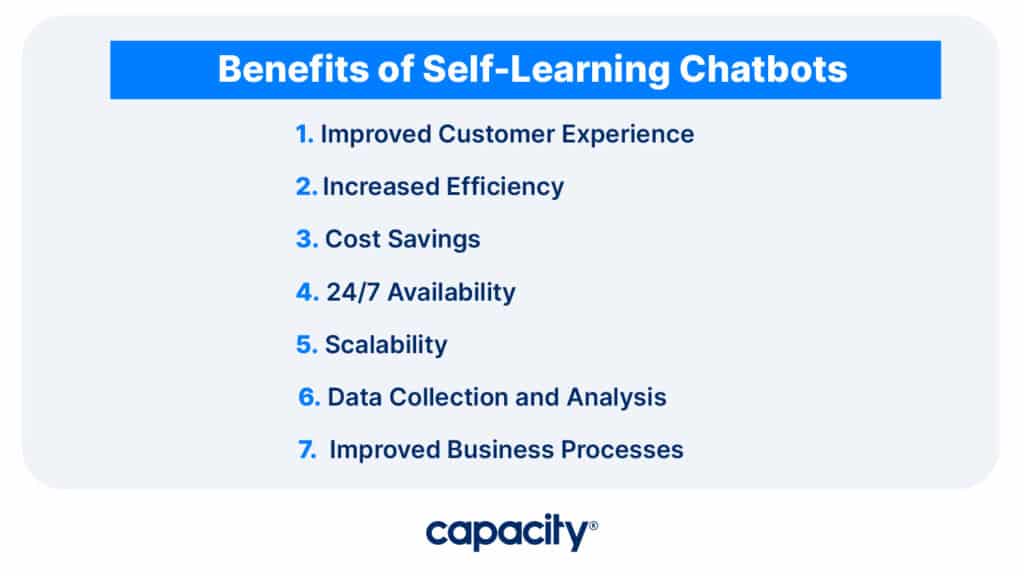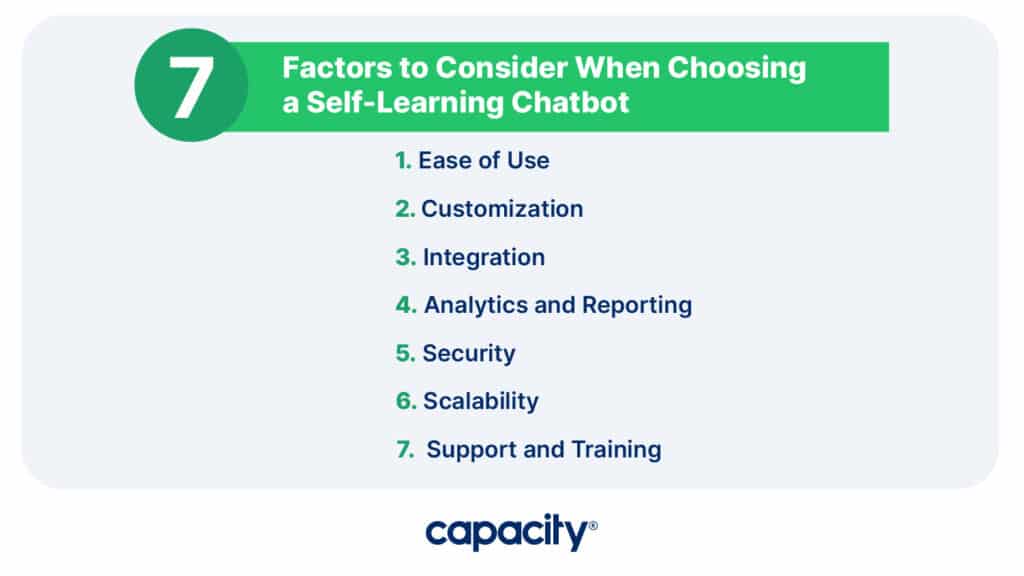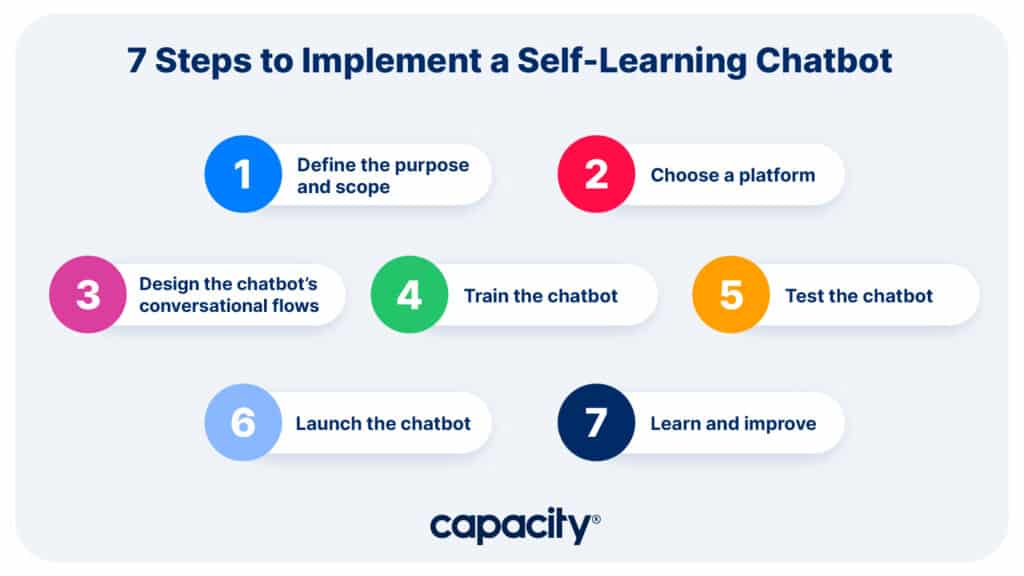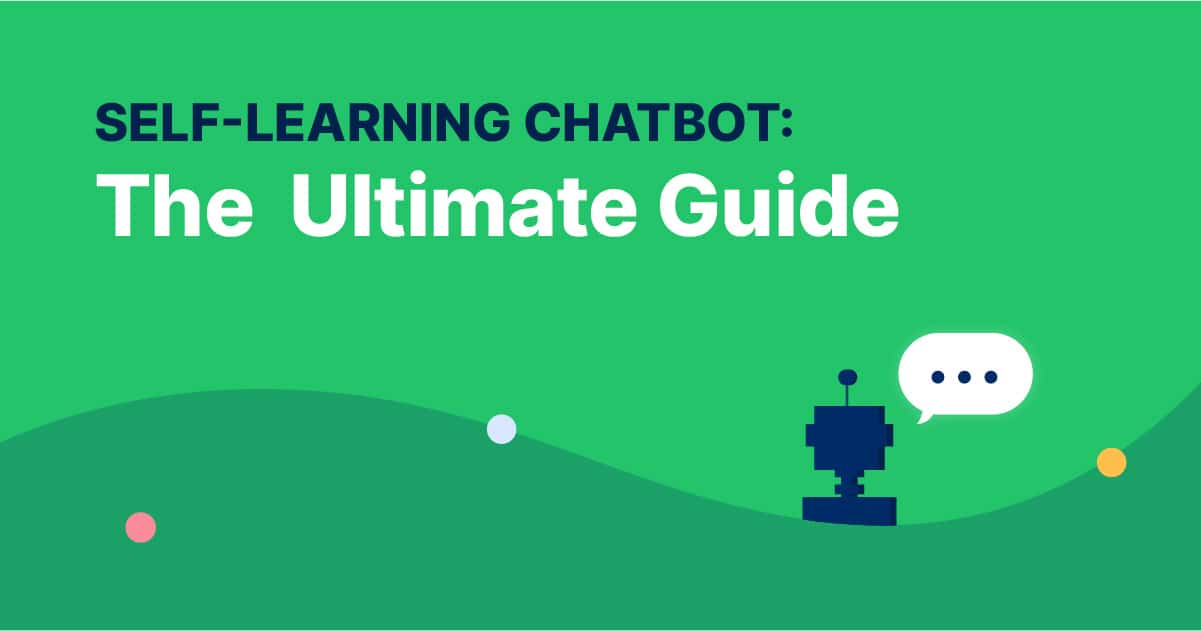Chatbots have existed for a considerable amount of time and have now become a crucial component of customer service for numerous companies. Nevertheless, with the advancement of AI technology, chatbots have also evolved, and one of the most powerful types of chatbots is the self-learning chatbot.
If you’re unfamiliar with self-learning chatbots and how they can improve your customer support, don’t fret. This article offers a comprehensive understanding of self-learning chatbots, including their definition, advantages, tips for selecting a suitable platform, and the necessary steps to implement one.
By the end, you will have acquired the knowledge to make an informed decision regarding implementing a self-learning chatbot for your business.

Automate Your Work
Capacity’s enterprise AI chatbot can help:
- Answer FAQs anytime, anywhere
- Find relevant documents within seconds
- Give surveys and collect feedback
What is a Self-Learning Chatbot?
Let’s start with the basics. In short, a chatbot is a program that utilizes artificial intelligence (AI) to imitate human conversation, permitting individuals to interact with it through messaging or speech. Chatbots have recently gained popularity, and businesses are utilizing them to automate customer service, offer round-the-clock assistance, and perform other tasks.
A self-learning chatbot, also known as an AI or intelligent chatbot, is a type that uses machine learning algorithms to enhance its performance over time continuously. This indicates that the chatbot can acquire knowledge from user interactions and modify its responses accordingly.
In contrast to conventional chatbots designed to reply to particular keywords or phrases, self-learning chatbots benefit from natural language processing (NLP) and machine learning to understand the intent behind a user’s message. As a result, they can deliver individualized and context-appropriate replies.
Chatbots that learn autonomously can enhance their performance without requiring any human involvement. They use feedback mechanisms, such as user ratings and sentiment analysis, to evaluate their performance and adjust their algorithms. This allows them to adapt to changing user needs and preferences and ultimately provide a better user experience.

Benefits of Self-Learning Chatbots
Self-learning chatbots offer several benefits over traditional ones, including:
Improved Customer Experience
Self-learning chatbots are made to understand the intent behind a customer’s message, which allows them to provide personalized and relevant responses. This enhances the overall customer experience, resulting in heightened customer contentment and loyalty.
Increased Efficiency
Self-learning chatbots can handle many queries and requests without human intervention. This allows businesses to save resources, boost response times, and reduce customer wait times.
Cost Savings
By implementing automated customer service and support, companies can reduce expenses related to recruiting and training human agents. Self-learning chatbots can manage a significant volume of queries while costing a fraction of what a human agent would.
24/7 Availability
Chatbots that learn autonomously can operate non-stop without requiring any breaks or time off. This implies that companies can offer 24/7 support to their customers, irrespective of their location or time zone.
Scalability
Self-learning chatbots can handle many requests and be easily scaled up or down to meet changing business needs. This makes them a flexible and cost-effective solution for businesses of all sizes.
Data Collection and Analysis
Chatbots that learn autonomously can gather and assess customer interaction data, including customer preferences and feedback. This information can be utilized to refine the chatbot’s performance and gain an understanding of customer behavior and preferences.
Improved Business Processes
Chatbots that learn independently can automate tedious and time-consuming duties such as order processing and data entry. As a result, workers can devote more of their time to more important responsibilities like customer service and sales.
In general, chatbots that can learn independently provide several advantages to companies seeking to enhance their customer support and service functions. They can boost productivity, lower expenses, and improve the customer experience, rendering them a beneficial asset for businesses of any scale.

How to Choose a Self-Learning Chatbot Platform
Choosing the right self-learning chatbot platform can be overwhelming, as several alternatives are available. Below are several essential factors to keep in mind when choosing:
- Ease of Use – The chatbot platform designed for self-learning should be user-friendly and straightforward to operate. It should feature an intuitive interface that enables non-technical users to create and manage chatbots effortlessly.
- Customization – The chatbot platform should provide customization options to tailor the chatbot’s responses and behavior to match the specific needs of your business.
- Integration – The platform should integrate seamlessly with your existing systems, such as your website, social media platforms, and customer relationship management (CRM) software.
- Analytics and Reporting – The chatbot platform ought to offer comprehensive analytics and reports for monitoring its effectiveness and pinpointing opportunities for enhancement.
- Security – The platform’s robust security measures are essential to safeguard customer data and ensure compliance with data protection regulations.
- Scalability – The platform should be scalable and able to handle growing users and interactions without compromising performance.
- Support and Training – The chatbot platform provider should offer comprehensive support and training to ensure users get the most out of it.
Ultimately, these elements will help you choose the self-learning chatbot that aligns best with your business requirements. The right platform can help you improve customer satisfaction, reduce response times, and increase efficiency while reducing costs.

Steps to Implement a Self-Learning Chatbot
Deploying a self-learning chatbot may appear daunting, but it can be a simple process with the correct approach. Here are the steps you can follow:
Define the Purpose and Scope
When implementing a self-learning chatbot, the initial step is establishing its purpose and scope. This involves identifying the types of queries your chatbot will handle and the platforms it will operate on. Doing so lets you determine the necessary features and functionalities that should be included in your chatbot.
Choose a Self-Learning Chatbot Platform
Select a self-learning chatbot platform that aligns with your business needs and the scope you defined. Ensure the platform has the customization options, integration capabilities, and analytics and reporting tools you require.
Design Conversational Flows
Develop conversational flows that illustrate the interactions your chatbot will have with customers. Define the questions your chatbot will ask, the responses it will provide, and the actions it will take based on customer inputs.

Automate Your Work
Capacity’s enterprise AI chatbot can help:
- Answer FAQs anytime, anywhere
- Find relevant documents within seconds
- Give surveys and collect feedback
Train the Chatbot
Train the chatbot by feeding it relevant data, such as frequently asked questions (FAQs), customer service transcripts, and product information. This data will enable the chatbot to learn how to respond to customer queries efficiently.
Test the Chatbot
Conduct testing on the chatbot to uncover any problems and make necessary adjustments. Before launching it to a broader audience, try the chatbot with a small group of users.
Launch the Chatbot
Once you have tested the chatbot and resolved any issues, launch it to your customers. Track the chatbot’s performance and modify it to enhance its effectiveness.
Continuously Improve
Additionally, the self-learning chatbot should be continuously improved by monitoring customer feedback and making necessary changes to the chatbot’s responses and behavior. Use the analytics and reporting tools available through the chatbot platform to identify opportunities for enhancement and continually fine-tune the chatbot’s performance.
Implementing a self-learning chatbot requires careful planning and execution, but it can significantly benefit your business by providing efficient and personalized customer support. By adhering to these guidelines, you can develop a chatbot that improves customer satisfaction and aligns with your business requirements.
Final Thoughts
To sum up, a self-learning chatbot is a powerful tool businesses can use to improve customer support and automate repetitive tasks. Using machine learning algorithms, these chatbots can learn from customer interactions and gradually offer more precise and tailored responses.
One such tool that stands out in this space is Capacity, an AI-powered support automation platform that provides seamless integration with a business’s tech stack. With its conversational AI interface and powerful workflow automation suite, Capacity enables enterprises to automate their support and business processes, answer more than 90% of their FAQs, and increase productivity in cross-functional teams.
They can also automate tedious processes and tasks, allowing their teams time to focus on more critical tasks. Additionally, with the flexibility of Capacity’s database, businesses can access their data and insights from anywhere in the world, making it a precious tool for those with distributed teams or operating in multiple locations.
As the AI technology behind self-learning chatbots advances, we can expect tools like Capacity to become the new norm, providing businesses with an even greater competitive edge.





